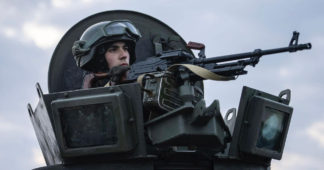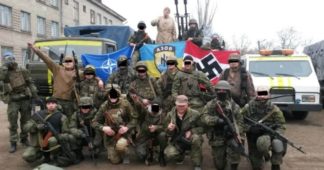By Jason Melanovski
The New York Times has verified the authenticity of videos apparently showing the execution of 11 surrendering Russian soldiers in the village of Makeyevka, Luhansk, in Eastern Ukraine earlier this month.
One video was filmed by an unnamed Ukrainian soldier on his cell phone, while other footage comes from drone videos that were most likely filmed by Ukrainian forces surveilling the offensive. The Times compared the videos to satellite imagery, confirming that they had been filmed at a farmhouse in the village.
One of the videos first circulated on pro-Ukrainian social media channels last week. In the video, Russian soldiers can be seen clearly in the process of surrendering to Ukrainian forces when one Russian soldier appears from the background and opens fire. The Ukrainian forces seem to return fire.
The video cuts and the same Russian soldiers are shown lying dead on the ground, most of them positioned as they were when they surrendered, apparently executed at point blank range in the back of the head. The Russian soldier who had opened fire appears to also have been killed on the spot and is lying in the position from where he opened fire.
Commenting on the videos, Dr. Rohini Haar, medical adviser at Physicians for Human Rights, told the New York Times, “It looks like most of them were shot in the head. There are pools of blood. That indicates that they were just left there dead. There appears to have been no effort to pick them up or help them.”
Dr. Haar added that because the Russian soldiers had been lying down, apparently unarmed, with their arms outstretched or behind their heads, “They’re considered hors de combat, or noncombatants—effectively prisoners of war.”
Russia has denounced the killings as“deliberate and methodological murder.”
As the Times article admits, the Ukrainian soldiers could be prosecuted for the extrajudicial killing of Russian POWs under the laws of international armed conflict, including the Geneva Conventions and the Rome Statute, the international treaty that established the International Criminal Court. According to the Geneva Conventions, POWs “must at all times be humanely treated. Any unlawful act or omission by the Detaining Power causing death or seriously endangering the health of a prisoner of war in its custody is prohibited, and will be regarded as a serious breach of the present Convention. … Measures of reprisal against prisoners of war are prohibited.”
Similarly, the Rome Statute says that “Killing or wounding a combatant, who, having laid down his arms or having no longer means of defense, has surrendered at discretion” constitutes a violation of international armed conflict.
The fact that the video first appeared on pro-Ukrainian social media channels suggests that Kiev was already aware of the extrajudicial execution and leaked the video as part of a PR campaign to blame the sole Russian soldier firing upon Ukrainian troops for the death of all 11 soldiers. As even the Times admitted, “Ukrainian news and social media channels … used them to laud the military prowess of their armed forces and publicize their heroic retaking of territory lost to Russia early in the war.”
In response to widespread criticism of the conduct of the Ukrainian soldiers, the Ukrainian government has pleaded ignorance and promised an investigation, which it knows full well will have no impact on the support it receives from its imperialist backers. Speaking at a security forum in Canada, Olha Stefanishyna, Ukraine’s deputy prime minister, stated, “Of course Ukrainian authorities will investigate this video,” but added that it “is very unlikely” the video accurately depicted the execution of Russian POWs.
Despite Stefanishyna’s assurances that Ukraine does not engage in the killing of POWs, in March another video circulated widely on social media showing Ukrainian forces shooting captured Russian soldiers in the legs at point blank range. During the initial weeks of the war, official social media accounts of the Armed Forces of Ukraine also regularly posted gory photos of dead Russian soldiers. Such behavior is clearly encouraged within the Armed Forces of Ukraine, which includes neo-fascist organizations such as the Azov Regiment and the Right Sector.
That the Ukrainian media were so quick to celebrate the killing of Russian POWs suggests the widespread release of the video is a deliberate provocation by Kiev to continue the war amid reports of pressure from Washington D.C. to reopen negotiations with Moscow as winter approaches. So far, the Zelensky government has refused to take any steps to initiate negotiations and even passed a law forbidding negotiations for as long as Vladimir Putin remains president.
The release of the video has had the predictable effect of angering pro-war nationalist elements within Russia, who have been pushing Moscow to widen its reactionary and disastrous war in Ukraine despite immense losses. As the Times reported, Vladlen Tatarsky, a popular Russian military blogger, said in a post on Telegram that every Russian “must watch this several times to understand whom we are fighting against” and that “not a single Russian can live and sleep calmly … as long as the perpetrators are alive.”
While recent Ukrainian military successes—the retaking of large parts of Kharkov and Kherson provinces—have been celebrated both in Ukrainian and the western imperialist media, the war is, by any standard, a historical disaster for the population of both countries. Last week, General Mark A. Milley, chairman of the Joint Chiefs of Staff, estimated that over 100,000 Russian soldiers have been killed or injured and “probably” an equivalent number of Ukrainian soldiers have been as well, putting the total casualty number in the ongoing war at over 200,000.
We remind our readers that publication of articles on our site does not mean that we agree with what is written. Our policy is to publish anything which we consider of interest, so as to assist our readers in forming their opinions. Sometimes we even publish articles with which we totally disagree, since we believe it is important for our readers to be informed on as wide a spectrum of views as possible.











